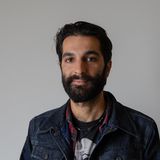On October 12th, Indigenous Peoples in different parts of the world are resisting the celebration of Columbus day and are remembering Indigenous resistance against colonisation. Columbus’ arrival in 1492 meant the start of European colonialism and the invasion on the continent of Abya Yala (the Americas). In Venezuela since 2002 “Indigenous Resistance Day” is a National Day of Celebrating Indigenous Resistance against Spanish invaders. In 2021 the USA followed, where October 12th is now called Indigenous Peoples’ Day.
October 12th not only marks the symbolic beginning of colonisation for Indigenous Peoples, but it’s also the start of chattel slavery for African People and the emergence of the globalised European capitalist system that we know today. It is therefore important to collectively embrace October 12th as an important date to resist and remember past, present and future colonialism. This is why Pakhuis de Zwijger is hosting Indigenous Liberation Day this year in collaboration with Aralez and a coalition of parties.
Below we share five reasons why it is important to join and support Indigenous Liberation Day on October 12th. A day full of protest, with cultural performances, talks, exposition and dialogue.
Invisibility of Indigenous Colonial History
Through decades of grassroots activism, the Dutch history of the transatlantic slave trade has gained visibility, leading to apologies from different Dutch municipalities and resulting in processes of truth-seeking, historical research, commemorations, and discussions on reparations.
However, when it comes to recognition for the genocide committed against Indigenous Peoples, the ongoing land theft, environmental destruction and the cultural destruction of Indigenous People’s way of life and their livelihoods, it remains very much silent throughout our society. How is this invisibility possible while the Dutch have built their labour plantation camps with enslaved African people on Indigenous lands in the first place?
Impact of European colonisation for Indigenous Peoples.
About 175 million Indigenous people died between 1492 and 1900 on the American continent as a consequence of wars, genocide, enslavement, deportations, mass ecocide and the newly introduced diseases that could fester in such a societal collapse. CARICOM, a coalition of Caribbean countries, estimated that Indigenous Peoples in the Caribbean region consisted of three million Indigenous people in 1700. The number was reduced to 30,000 in 2000, a decrease in population of 99%.
In Surinam, a Dutch colony, the population of Indigenous people prior to colonialism was estimated to be 70,000 in 1492, of which only 1,400 Indigenous people remained in 1920, a decrease of approximately 98% in population (Armand Zunder, 2012). Another example in the eastern part of Dutch empire is the infamous genocide of JP Coen committed on the Banda Islands towards the Indigenous inhabitants, in order to gain a monopoly on nutmeg. In the second half of the 20th century, a western-backed dictatorship in Indonesia committed genocide against hundreds of thousands of Indigenous peoples in East-Timor and West-Papua, bringing colonial history right up to the present.
Acknowledge Indigenous Genocide & Racism.
After the physical displacement and murder of Indigenous Peoples, the last phase of colonialism was focussed more on assimilation policies by brining so called ‘civilisation’. State policies forcefully removed thousands of Indigenous children from their families and their communities. They were brought to boarding schools and/or adopted into Christian families to be raised according to western values. These policies were put into effect through racist ideologies that portrayed Indigenous cultures as inferior and primitive. To exhibit European superiority human Zoos were commonplace in European colonial societies. In 1883, for example, Indigenous and Black people from Dutch colonies were exhibited in the ‘Wereldtentoonstelling’ behind the famous Rijksmuseum in Amsterdam.
Standing for true diversity: lacking space in Amsterdam
The municipality of Amsterdam usually celebrates ‘diversity’ by mentioning the more than 180 nationalities based in its city. However, someone can be a Mapuche from Chile, a Kalinya from Surinam, or an Igorot from the Philippines. This passport diversity makes the more than 6500 languages and cultures that are spoken and practiced across the globe invisible. Due to the imposition of European languages and the current nation state system more than half of all languages will disappear by the end of this century. Amsterdam has not yet provided any space or cultural facilities for Indigenous diaspora to practice their cultural values and traditions. Passing on your culture to the next generation becomes difficult when there is no cultural house or space for Indigenous peoples.
Climate Justice
Indigenous Peoples have protected 80% of biodiversity, while only comprising 5% of the World’s Population. However, Indigenous Peoples rights across the globe are continuously being violated by being forcefully displaced from their land through corporate land theft. Frontline land defenders are killed on a weekly basis or often times framed as terrorists. While they protect most of our biodiversity, less than 1% of global sustainability finances actually serve these frontline Indigenous communities. It is time to challenge this inequality and climate racism. It is because our future survival as humanity is connected with the future survival of Indigenous peoples. It is important to be in solidarity. If they die, we will all die.
Sign up
Did this article spark your interest and do you want to learn more about Indigenous Peoples, colonisation and resistance?
Sign up here for the “Indigenous Liberation Day Festival: Repairing our Past, Present and Future” at Pakhuis de Zwijger on October 12th.
Also on October 4th, there will be a lecture about “The American Holocaust“, the lecture will look at the colonisation of Turtle Island/Abya Yala and reflect on one of the biggest genocides that ever took place. Reserve your seat here.








